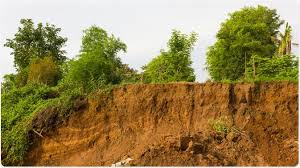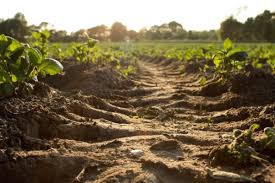Soil is the uppermost part of the earth’s crust that supports plant growth. It serves as a medium from which plants absorb nutrients necessary for growth and development, and it also houses microorganisms that contribute significantly to ecosystem balance.
Given the vital role of soil in agriculture and the ecosystem, protecting it from degradation is essential. This article addresses the concept of soil erosion, a major threat to soil integrity when left unmanaged.
Definition of Soil Erosion in Agricultural Context
Soil erosion is the gradual removal of the top layer of soil by agents such as water, wind, ice, and glaciers. These agents transport soil particles across distances, leading to a reduction in soil fertility. In arid regions, wind is the predominant agent, while in humid regions, water is the major cause.
Read Also: 14 Medicinal Health Benefits of Epimedium grandiflorum (Horny Goat Weed)
Types of Soil Erosion Affecting Agriculture

There are five (5) major types of soil erosion:
1. Splash Soil Erosion – Occurs when raindrops hit bare soil, detaching particles and making them susceptible to further erosion.
2. Sheet Soil Erosion – The even removal of a thin layer of topsoil from a large area, especially land with sparse or no vegetation.
3. Rill or Finger Soil Erosion – Develops as small channels form from running water, which may later expand into gullies.
4. Gully Soil Erosion – A more advanced stage of erosion that creates deep channels in the land, often rendering farmland uncultivable.
5. Wind Soil Erosion – Common in arid and semi-arid zones, where wind carries soil particles away, leading to the formation of sand dunes and loss of fertile soil.
Detailed Explanation of Soil Erosion Types
1. Sheet Soil Erosion in Farmland: Sheet erosion wears away the topsoil on land with minimal vegetation. This results in the exposure of infertile subsoil, causing nutrient loss. It becomes noticeable when plant roots or subsoil are exposed.
2. Rill or Finger Soil Erosion and Its Impact: Rill erosion begins with small water channels, often formed during surface runoff. These channels resemble fingers on the soil surface and may evolve into gully erosion if not controlled. It is among the most damaging forms of soil degradation in farming.
3. Gully Soil Erosion and Farmland Destruction: Gully erosion is an advanced form of rill and sheet erosion. Unchecked water flow deepens the channels, cutting through soil layers. Large gullies can destroy farmlands and make cultivation impossible.
4. Splash Soil Erosion from Rainfall: Splash erosion begins with rainfall hitting bare soil, dislodging particles. These loose particles are then easily washed away, leading to further erosion such as sheet and wind erosion.
5. Wind Soil Erosion in Dry Areas: This type of erosion is prominent in dry zones with little vegetation. Strong winds lift and transport loose soil particles, reducing soil fertility and forming sand drifts.
Factors Influencing Soil Erosion in Agriculture
The severity of soil erosion in a region is influenced by several factors:
1. Soil structure and composition: Poorly structured soils are more prone to erosion.
2. Vegetation cover: Sparse vegetation allows erosion agents to affect soil directly.
3. Topography of the land: Steep slopes accelerate surface runoff and soil loss.
4. Agricultural practices: Poor farming methods expose soil to erosion.
5. Deforestation: Removing trees destabilizes soil and encourages erosion.
6. Road construction and urbanization: These activities disturb the land and cause runoff.
7. Climate changes (global warming): Altered rainfall patterns intensify erosion risks.
8. Bush burning: Destroys protective plant cover, making soil more vulnerable.
Effects of Soil Erosion on Agricultural Land
1. Land degradation: Reduces soil fertility and structure.
2. Sedimentation of aquatic ecosystems: Runoff carries soil into water bodies.
3. Water pollution: Eroded soil contaminates water sources.
4. Air pollution (dust): Wind erosion spreads dust in the air.
5. Leaching of soil nutrients: Nutrients are washed beyond reach of crops.
6. Reduced size of farmland: Erosion limits the usable land area.
7. Reduction in crop yield: Less fertile soil leads to lower productivity.
Control Measures for Soil Erosion in Agriculture

Effective soil erosion control involves strategies to minimize soil loss due to runoff, tillage, wind, and human activities. These include:
1. Terracing for Slope Management: Terracing combines contouring and land shaping. Earth embankments intercept and channel water safely, decreasing slope length and gradient. This slows runoff and prevents soil loss.
2. Contouring for Erosion Control: All farming activities, including tillage and planting, are done across slopes. This slows water movement, allowing moisture infiltration and reducing erosion risk.
3. Cover Cropping for Soil Protection: Cover crops spread across the soil surface, shielding it from raindrops and wind. They also improve soil structure and fertility, especially when leguminous plants are used.
4. Tillage Practices to Reduce Erosion: Improper tillage exposes soil. Suitable tillage methods, sometimes involving zero tillage, leave soil rough and protected with crop residues, enhancing infiltration and minimizing runoff.
5. Strip Cropping for Land Conservation: Two or more crops are planted in alternating strips across slopes. Soil-conserving crops trap particles detached from row crops, reducing runoff and wind effects.
6. Mulching for Surface Protection: Applying mulch such as straw, compost, or plastic reduces evaporation, suppresses weeds, and protects soil from raindrop impact and wind, allowing seedlings to establish safely.
7. Vegetated Waterways to Reduce Runoff Velocity: Grassed channels reduce water flow speed and absorb energy that causes erosion. Hardy, perennial grasses are used to stabilize these channels and guide runoff safely.
8. Conservation Tillage for Organic Matter: Leaving crop residues after harvest enhances soil structure and reduces particle detachment. This practice is especially effective on slopes cultivated with annual crops.
9. Wind Breaks for Wind Erosion Control: Planting rows of trees across wind direction reduces wind speed. These trees trap airborne particles, create microclimates, and support biodiversity while protecting soil.
Soil erosion is a destructive force in agriculture, threatening not only crop yield but also infrastructure like roads and buildings. Its impact extends to water systems and air quality.
Implementing effective erosion control measures is crucial to preserving soil health and ensuring sustainable agricultural productivity.

